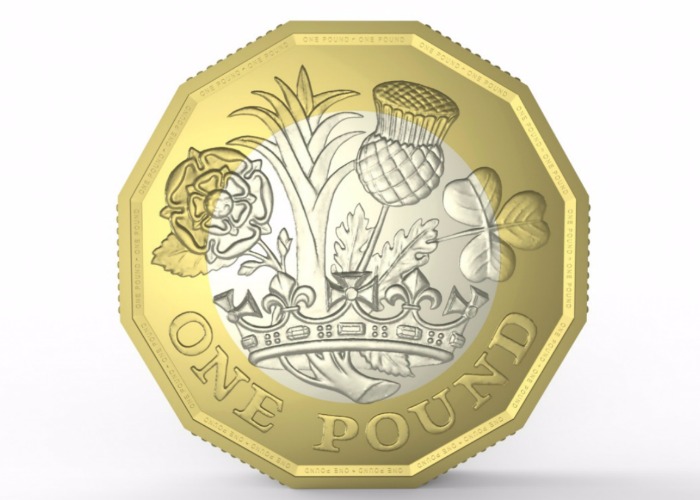Rare pound coins: is your new one pound valuable?

Some rare new one pound coins contain variances that could either make them valuable or completely worthless. We explain what's happening, and also round up how you can spot other £1 coins that are worth a mint.
Sections
Is my faulty one pound coin valuable?
Rare pound coins that contain defects are currently in circulation, the Royal Mint has confirmed.
A “small number” of the new 12-sided £1 coins contain certain “variances”: these vary from one to the next, but we have seen reports of coins that are out of shape, misaligned or lacking key details.
“As you would expect, we have tight quality controls in place, however, we expect variances in a small number of coins, particularly in the striking process, due to the high volumes and speed of production,” a Royal Mint spokesperson told us.
Exactly how many coins contain defects remain unclear, but as it’s almost certainly a tiny percentage of the 1.5 billion being minted overall, it follows that they will be worth more than face value on account of their rarity.
Thousands of coins have already surfaced on auction sites with bids well in excess of £1.
Some valuable, some not
If you are interested in buying one of these coins, you should proceed with caution.
The Mint is warning that some opportunists might be deliberately manipulating coins and selling them off as coins with defects from the striking process.
In particular, you should be weary of coins where the inner part has been separated.
“We have observed a number of coins with separated and reversed inners and outers for sale on online auction sites,” a spokesperson told us.
“Our belief is that these have been deliberately manipulated and we would remind people that breaking up a UK coin is illegal under the Coinage Act 1971.”
A quick scan of eBay shows these are indeed the most common ‘defective’ coins being advertised.
Should you have a concern about the new £1 coin, you can email the Royal Mint at this address: newonepoundcoin@royalmint.com.
If you do land yourself with a ‘faulty’ coin but can’t be fussed trying to flog it to a buyer for a small profit, rest assured you can simply spend it like any other coin.
“Members of the public can be confident that the number of coins that may contain errors is extremely small and that they can continue to be used,” the Mint’s spokesperson says.
It's not just the faulty ones that are catching the eye of collectors. Unlike the new fiver, the coins don’t have a serial number so it’s not as easy to tell which ones are valuable.
In the rest of this article, Alex Cassidy, from GoCompare’s Coining It In, explains what people should be looking out for.
Want to find out if your old round pounds are valuable? Head this way.
Want more stories like this? Visit loveMONEY homepage or sign up for our daily newsletter and let us send the news to you!
Misaligned dies
The new coins are bi-metallic, with a golden outer edge and a silver inner disc.
Even though they’re checked thoroughly before they’re signed off, some coins might have slipped through the net and have misaligned dies. Lucky for you, this makes them more valuable.
"Punters should pay attention to both the floral crown on the reverse side for any rotations, as well as the Queen's head, which should sit directly above the new bevelled edge," explains Cassidy.
Switch current accounts to get a better deal today
Trial coins
Over 200,000 coins were sent to retailers for testing before the coin was officially released. They were classed as ‘trial coins’ rather than legal tender but even still, they’re going on eBay for a lot of money.
Experts believe their value is going to grow even more, according to Cassidy:
"These new £1 trial coins are fascinating, especially considering the financial precedent of the £2 trial coins in 1994, which have since become one of the most sought after collectable coins in Britain."
"If these new trial coins turn out to be as valuable as 1994’s, then anyone who gets their hands on them now could be sitting on a future goldmine."
Valuable proofs
Coin and bullion dealer Chards believes there are some valuable ‘proof’ coins out there.
These coins are special pre-production samples used for ‘approval’ purposes and finished to a much higher standard than the regular coins.
In a statement, Chards said: "Bear in mind they are producing over 2.2 billion £1 coins this year.
"We do not think that the 2017 circulation £1 coin will be a good investment. However, the collector coins such as the silver proof, silver proof piedfort and gold proof will be the ones to invest in."
Create your own user feedback survey
Upcoming alternative designs
Watch out for the first batch of coins commemorating Jane Austen, Sir Isaac Newton and the Royal Flying Corps as these could soar in value over the coming months.
"2017 is expected to be a good year for collectors, with the trend of 50p collectable limited release coins continuing into the new £1 coins," Cassidy told Mirror Money.
"That's the main thing to look out for in the near future, because the first run of those collectables will be huge."
Compare current accounts with loveMONEY
Read more about the new £1 coin
New £1 coin: everything you need to know
Comments
Be the first to comment
Do you want to comment on this article? You need to be signed in for this feature